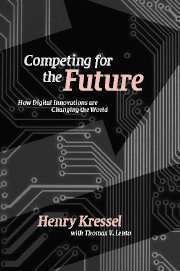Book contents
- Frontmatter
- Contents
- List of figures
- List of tables
- Acknowledgements
- Introduction
- Part I The technology – how electronic devices work – digital systems and software
- Part II Innovators, entrepreneurs, and venture capitalists
- Part III Global reach, global repercussions
- Appendix 1.1 Smaller, faster, more efficient MOSFETs
- Appendix 1.2 Building multi-transistor logic gates
- Appendix 1.3 MOSFETs in memory devices
- Appendix 1.4 CMOS reduces logic gate power dissipation
- Appendix 1.5 Laser diode basics
- Appendix 1.6 Light-emitting diodes (LEDs)
- Appendix 1.7 Photodetectors
- Appendix 1.8 Making fiber optic cables
- Appendix 1.9 Principles of LCD displays
- Appendix 2.1 The demise of analog computers
- Appendix 2.2 IP, TCP, and the Internet
- Appendix 2.3 Building an object-oriented program
- Index
Appendix 2.1 - The demise of analog computers
Published online by Cambridge University Press: 07 December 2009
- Frontmatter
- Contents
- List of figures
- List of tables
- Acknowledgements
- Introduction
- Part I The technology – how electronic devices work – digital systems and software
- Part II Innovators, entrepreneurs, and venture capitalists
- Part III Global reach, global repercussions
- Appendix 1.1 Smaller, faster, more efficient MOSFETs
- Appendix 1.2 Building multi-transistor logic gates
- Appendix 1.3 MOSFETs in memory devices
- Appendix 1.4 CMOS reduces logic gate power dissipation
- Appendix 1.5 Laser diode basics
- Appendix 1.6 Light-emitting diodes (LEDs)
- Appendix 1.7 Photodetectors
- Appendix 1.8 Making fiber optic cables
- Appendix 1.9 Principles of LCD displays
- Appendix 2.1 The demise of analog computers
- Appendix 2.2 IP, TCP, and the Internet
- Appendix 2.3 Building an object-oriented program
- Index
Summary
In Chapter 1 we pointed out the difficulty of using vacuum tubes for large-scale digital data processing.
This observation, while perfectly true, begs the question, why shift to digital in the first place? We live in the natural world, which is defiantly analog. It seems logical that analog systems would process information from the analog world more efficiently than their digital counterparts.
On the surface they do seem more efficient. In analog electronic systems a smoothly variable electrical quantity (such as voltage, capacitance, or current) is used to represent information. The value of the electrical property is directly proportional to the magnitude of the physical signal being processed or transmitted.
Suppose, for example, you want to measure the intensity of light in a room. You place a photodetector (an analog light sensor) there. When light hits the device, it responds either by generating an electrical current or by permitting such a current to flow. As the light gets stronger, the current flowing in the system becomes greater as well.
The current increases in a linear fashion, allowing you to track and record the level of light falling on the photodetector. The term “linear” is used to describe analog systems because, under ideal conditions, their electrical information varies in line with the received signal.
Human beings are analog systems, too. We respond in a linear fashion to external analog signals such as temperature, sound, light, and images.
- Type
- Chapter
- Information
- Competing for the FutureHow Digital Innovations are Changing the World, pp. 377 - 380Publisher: Cambridge University PressPrint publication year: 2007



